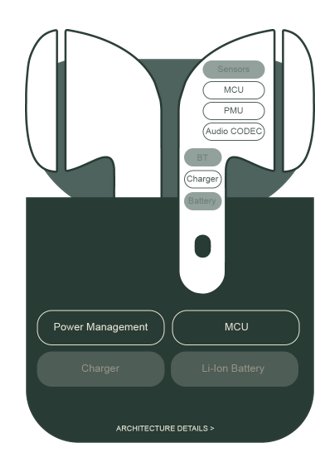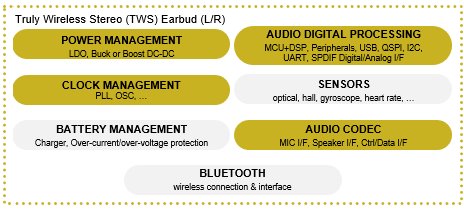Paving the way for the next generation audio codec for the True Wireless Stereo (TWS) applications - PART 1 : TWS challenges explained
PART 1 : TWS challenges explained
By Hai YU, Clément MOULIN (Dolphin Design)
The audio market for wireless Bluetooth headsets is growing rapidly. Audio devices using Bluetooth (BT) connectivity are more ubiquitous than ever. People have gotten used to wireless audio systems, and the mobile phone industry is pushing towards a world without audio connectors and cables. The latest trend in wireless headsets and speakers is True Wireless Stereo systems (TWS), consisting of two independent units that are each charged in their own charging case. These headsets or speakers are typically connected through Bluetooth to an audio source while some contain additional memory to store music. TWS smart devices often contain integrated Active Noise Cancellation (ANC) to eliminate unwanted background noise from the received audio and at the same time minimize disturbances in the transmitted audio stream e.g., during voice calls.
1) What is True Wireless Stereo (TWS) technology?
True Wireless Stereo (TWS) uses Bluetooth signals instead of wires or cables to transfer sound. TWS differs from existing wireless accessories that do not physically connect to a media source but still rely on physical connections to ensure that both audio channels function together. As they are not connected to each other, the left- and right-side headphone of Bluetooth TWS can work independently. Technically, this means that a mobile phone is connected to the main headphone through Bluetooth wireless connection. Then the main headphone connects with the slave speaker through a Bluetooth wireless connection, thus achieving true wireless Bluetooth between both separate left and right channels of the Bluetooth headphones.

Fig. 1: TWS earbuds system view
Every TWS device has a built-in chip responsible for sending and receiving audio signals wirelessly via Bluetooth between the audio playback device (earbuds or speakers) and the media source (phone, computer, TV, etc.). True wireless technology is not limited to usage by earbuds, though it is by far the most popular usage. Other common applications use it for stand-alone speakers.

Fig. 2: True Wireless Stereo Bluetooth connections
True Wireless uses a single (master) earbud/speaker to create a primary connection to the media source and then connect to the secondary earbud/speaker, to create a True Wireless Stereo connection. Information including L and R channels is then sent to the primary connection using the master device, then the L channel is forwarded through the secondary connection to the slave device. This gives the listener the immersive True Wireless Stereo sound.
There is also a second approach of TWS implementation which consists in creating a connection between both earbuds/speakers at the same time. This allows the media source to connect to both earbuds/speakers simultaneously. The chips within the earbuds/speakers then allow the media source to send the L and R channels independently to the L and R earbuds/speakers. This prevents strain on a single earbud/speaker thus extending battery life, improving the connection strength, and allowing for a crisper, clearer audio experience, not to mention a much easier way to connect devices.
The TWS system evolution is at the very beginning but will soon reach its peak due to a strong, rapidly growing competitive market and high demanding customers. Improving miniaturization and consumption will facilitate the adoption of features and functionalities already known from standard Bluetooth headsets, like active noise cancellation (ANC), wireless charging, heart rate tracking or voice-enabled devices.
At CES 2020 the Bluetooth Special Interest Group (SIG) recently released a new standard, LE Audio, based on the new Bluetooth Low Energy radio, which will not only improve the audio performance of Bluetooth, but also bring a lower power consumption and higher sound quality experience, support multiple independent audio transmission, broadcast audio, audio sharing, and provide better support for hearing aids with more powerful hearing aid applications. LE Audio technology relies on the Bluetooth 5.2 core specification, and uses a new Low Complexity Communication Codec (LC3) to provide higher sound quality and lower power consumption. The LC3 decoder will bring greater flexibility to developers, allowing everyone to better balance key attributes such as sound quality, power consumption, and battery life when designing products.
LE Audio's Multi-Stream Audio makes TWS standard binaural transmission possible. It allows a single audio source device, such as a smartphone, to synchronize sending multiple and independent audio streaming transmissions to one or more receiving audio devices. In more common terms, multi-streaming audio enables all true wireless headphones to have a binaural transmission experience. Smartphones can transmit the same traditional audio signal to both ears at the same time without forwarding it, thereby improving the connection stability of Bluetooth headsets and reducing latency.
There are many advantages of TWS technology, providing total audio freedom with completely free hands. With the cable clutter gone, your living spaces look neat and orderly. It also provides the total versatility of sharing your music with others while wearing only one earbud at a time.
2) Which audio codec IP for TWS/ANC audio applications?
Compared to traditional wired headset chip design, TWS earbud or headset chip designers face many more challenges, with higher design requirements and tighter design constraints of inner chips. The following design challenges need to be considered in advance, before designing a Bluetooth TWS earbud chip.
- Enhanced and high-quality audio experience with a set of ambient-noise suppression solutions (hardware or software) especially for noisy ambient conditions, and a voice-activation feature for the system wake-up use.
- Extreme low power consumption to increase battery lifetime.
- Ultra-small silicon area of the chip and minimal electrical components (smaller IC package, simpler external schematic) due to the limited printed circuit board space.
- Aggressive product design cycles and high time-to-market pressure of the cutthroat TWS earbuds market.
- Manufacturability, the testability, and the production cost (very cost-sensitive).
- More and more sensors and features will be added into the TWS products (limited space), heart-rate monitoring, fitness tracking hearable, temperature, motion, light, gaming, etc., thus the signal processing capability is very challenging.
- BoM cost: In a cost-driven TWS earbuds/speaker market, reducing the Bill-of-Materials (BoM) costs becomes more and more critical. One of the main factors in selecting any component for TWS product development is cost, and audio codecs are no exception since the consumer market is very cost sensitive.
| Reducing BOM cost with Dolphin Design Codec IP Dolphin’s audio codec is specially designed to minimize the BoM cost and thus the space taken on the PCB. The microphone interface supports cap-less microphone inputs for the audio recording path. The headphone differential amplifier output supports cap-less BTL (Bridge Tied Load) for BoM cost optimization. |
Concerning the other challenges, Dolphin Design has also practical experience and knowledge of the more critical functionalities of TWS. Dolphin Design can provide silicon IP to chip/earbud makers allowing them to reach high performance and reduce time-to-market (refer to colored tiles highlighted in figure 3).

Fig.3: Functional blocks of a typical TWS earbud chip
The above functions will be detailed in the following parts of Paving the way for the next generation audio codec for the True Wireless Stereo (TWS) applications whitepaper:
- PART 2: Increasing play time
- PART 3: Optimizing latency key factor
- PART 4: Achieving ultimate audio experience
- PART 5: Cutting time to market in a safe manner
ABOUT THE AUTHORS
Hai YU received his PhD in Nano and Micro Electrical Engineering in 2011 from TIMA laboratory, Grenoble Alpes University for his work on low-cost highly efficient fault tolerant processor design for mitigating the reliability issues in nanometric technologies. Hai joined Dolphin Design in 2012 and is currently working as Lead Application Engineer, focusing on Audio & Processing IPs platform.
Clément MOULIN graduated from ENSEEIHT Toulouse in electronic and signal processing in 2006. After 8 year of leading hardware development in NFC domain, Clément joined Dolphin Design in 2020 and is currently working as an Application Engineer, focusing on Audio & Processing IPs platform.
ABOUT DOLHIN DESIGN
Headquartered in France, Dolphin Design, previously known as Dolphin Integration, is a semiconductor company employing 160 people, including 140 highly qualified engineers.
They provide differentiating platform solutions built on state-of-the-art IPs and architectures, customized by unique system level utilities to deliver fast and secure ASICs, either designed by or for their clients. These platforms are available for various technological processes and optimized for Energy Efficient SoC Design.
Alongside their clients, now exceeding 500 companies, they focus on human, inventive and long-term collaboration to enable them to bring products, powered by innovative and accessible integrated circuits that minimize environmental impact, to the hands of billions of people everyday. In consumer markets including IoT, AI and 5G, and in high reliability markets, they unleash SoC designer creativity to deliver differentiation.
Tell them your biggest dream. Dare the impossible. They tech it on.
Related Semiconductor IP
- Audio CODEC
- Parallel to AXI5 Bridge for Audio CODEC
- 24-Bit Stereo Audio Codec ADC, ADC SNR>95dB, DAC SNR>100dB - SMIC 55nm
- 24-Bit Stereo Audio Codec ADC, ADC SNR>95dB, DAC SNR>100dB - SMIC 40nm
- 24-Bit Stereo Audio Codec ADC, ADC SNR>95dB, DAC SNR>100dB - UMC 55nm
Related Articles
- Paving the way for the next generation of audio codec for True Wireless Stereo (TWS) applications - PART 5 : Cutting time to market in a safe and timely manner
- Paving the way for the next generation audio codec for True Wireless Stereo (TWS) applications - PART 2 : Increasing play time
- Paving the way for the next generation audio codec for True Wireless Stereo (TWS) applications - PART 3 : Optimizing latency key factor
- Paving the way for the next generation audio codec for TRUE Wireless Stereo (TWS) applications - PART 4 : Achieving the ultimate audio experience
Latest Articles
- Extending and Accelerating Inner Product Masking with Fault Detection via Instruction Set Extension
- ioPUF+: A PUF Based on I/O Pull-Up/Down Resistors for Secret Key Generation in IoT Nodes
- In-Situ Encryption of Single-Transistor Nonvolatile Memories without Density Loss
- David vs. Goliath: Can Small Models Win Big with Agentic AI in Hardware Design?
- RoMe: Row Granularity Access Memory System for Large Language Models